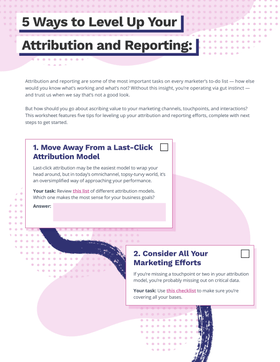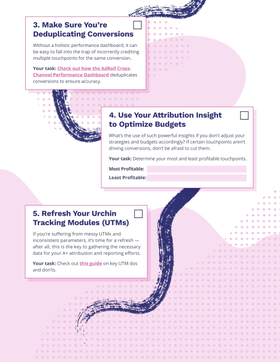Mobile Ad Attribution: How App Tracking Works
App tracking is essential for driving growth and ensuring you stay ahead of the curve. Let’s take a closer look at mobile app tracking and how it works.
Read More
Attribution and reporting are some of the most important tasks on every marketers’ to-do list — how else would you know what’s working and what’s not? Without this insight, you’re operating via gut instinct — and trust us when we say that’s not a good look.
But how should you go about ascribing value to your marketing channels, touchpoints, and interactions? Here are five tips for leveling up your attribution and reporting efforts, complete with next steps to get started. (Psst — use our worksheet to keep track of your tasks!)
Last-click attribution may be the easiest model to wrap your head around, but in today’s omnichannel, topsy-turvy world, it’s an oversimplified way of approaching your performance.
Your task: Review this list of different attribution models. Which one makes the most sense for your business goals?
If you’re missing a touchpoint or two in your attribution model, you’re probably missing out on critical data.
Your task:
Use this checklist to make sure you’re covering all your bases.
Without a holistic performance dashboard, it can be easy to fall into the trap of incorrectly crediting multiple touchpoints for the same conversion.
Your task:
Check out how the AdRoll Cross-Channel Performance Dashboard deduplicates conversions to ensure accuracy.
What’s the use of such powerful insights if you don’t adjust your strategies and budgets accordingly? If certain touchpoints aren’t driving conversions, don’t be afraid to cut them.
Your task: Determine your most and least profitable touchpoints.
If you’re suffering from messy UTMs and inconsistent parameters, it’s time for a refresh — after all, this is the key to gathering the necessary data for your A+ attribution and reporting efforts.
Your task: Check out this guide on key UTM dos and don’ts.
Last updated on April 28th, 2022.

